9. Conclusion: Assessment - www.hifilounge.eu
Main menu:
- Home
- General
-
Speakers
- Basics
- Speakers
- Headphones
- Subwoofer
- Elektronics
- Surround
- Photography
- Infos
9. Conclusion: Assessment
Speakers > Speakers
It is always difficult to make general statements about loudspeakers - especially since very few manufacturers publish complete measurements. A layman can only be strongly advised to listen to different loudspeaker concepts and form his own opinion.
Nevertheless, I would like to take the step and present characteristics of different loudspeakers and give a cautious assessment.
This section has been written with hesitation - and should be treated with caution. Many manufacturers of hifi speakers design loudspeakers with a deliberately discoloured diffuse field frequency response, sometimes also with a (deliberately) discoloured free field frequency response. The following lines refer exclusively (!) to neutrally tuned loudspeakers in the sense of low distortion and a continuous sound radiation that is as frequency-independent as possible - furthermore, it should be assumed that the loudspeakers are operated in a stereo triangle.
For musicians who want to mix music on the loudspeakers, it is important that the loudspeakers are free of discoloration and have an authentic stage image. And many hifiasts find such systems also convincing in longer comparisons. But this is not true for everyone! Some hi-fi enthusiasts use loudspeakers that have a strong sound of their own - omnidirectional loudspeakers placed close to the wall that integrate the spatiality of the listening room into the sound experience, loudspeakers with a "bathtub frequency response" that slightly emphasise the treble and bass, loudspeakers with discontinuities in the radiation that allow for a much more stable and concise (albeit artificial) stage presentation by means of specific excitation of the blue bands.
As a private user you are not bound to any standard or ideal of neutrality. Those who have found their own sound for themselves, even if it's a strongly discoloured full range driver with tube amplifier, can enjoy the resulting music. There is absolutely nothing to be said against helping out a little with an equalizer. But if you have understood how your favourite sound is created, you can usually achieve it cheaper and with fewer mispurchases than with try and error.
The following lines are written from the point of view of a person who prefers a neutral sound. But neutral does not mean boring - many pieces of music are reworked by sound engineers with equalizers and effect devices for the perfect sound, so that the music on the mostly quite neutral loudspeakers of the recording studios corresponds best to the artistic goals of the musicians. Silky highs and deep basses are then part of the recording - just like dirty guitar riffs or grandiose female voices.
Satellite systems
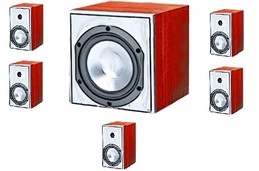
Figure 1: Satellite system
Satellite systems reproduce the mid/high range with fist-sized miniature speakers - the bass cannot be located and is reproduced by a subwoofer that can be positioned anywhere. In most cases the systems are offered as complete sorround systems.
These systems, disdained as "roaring cubes", sound surprisingly grown up in the meantime. Some systems have integrated amplifiers, usually integrated in the subwoofer. These can be connected directly to a PC or a BluRay player. For less than 200 Euros, systems can now be purchased that provide decent surround sound for computer games or home cinema applications.

If you are looking for an inexpensive entry-level system or a second system for your study - you can have a lot of fun with such a system. However, if you primarily listen to music - and have both space and money - you should go for larger speakers. The difference in sound is also audible for non-audiophiles.
The reason for this:
Especially with small satellites the midrange is missing completely due to the lack of necessary cabinet volume. If the lower midrange is reproduced by the subwoofer, it becomes clearly locatable and literally pushes itself into the sound image. In addition, the small speakers radiate a wide dispersion due to their physics and stimulate the room acoustics to the maximum. Due to the lack of diaphragm area and the resulting poor efficiency, the drivers quickly start to compress and sometimes even distort.
The usual Hifi shelf box
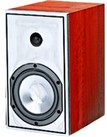
Figure 2: Shelf box
Compact boxes do it much better. Active versions with integrated volume control can be operated directly on the PC or on a BluRay player - for active speakers without volume control a preamplifier is absolutely necessary. Otherwise there is the classic compact speaker: Passive speakers connected to an AVR or integrated amplifier.
The target group of high-quality shelf speakers (or larger) is usually much more demanding than the target group for satellite systems, so speech and choice of words are much more critical in terms of sound characteristics in the following. Nevertheless, it should be made clear at this point that very good compact speakers are already available in moderate price ranges! If they are well placed they deliver a very tidy sound. If space and budget are limited a classic shelf speaker may be a very good solution.
The usual shelf speaker is 20-30cm wide and has a dome tweeter and a cone driver of 10-20cm diameter. The speaker radiates the grunton spherically through the narrow baffle, above the so-called bafflestep the speaker becomes a half-space radiator - at even higher frequencies the bundling increases even more. Classical bookshelf loudspeakers are usually developed with the aim of achieving the widest possible radiation: it should be possible to provide homogeneous sound to several adjacent seats. The low bass is limited by the lack of volume.
Unfortunately, the wide omnidirectional radiation strongly excites the room - when placed close to a wall, the direct reflections from the ear cannot be distinguished from the direct sound of the loudspeakers, so the combination of room and loudspeaker develops its own stage presentation.
Some pop recordings are sometimes specifically recorded in anechoic rooms. Now the stage presentation can create a sound stage through the mixture of loudspeakers and acoustics, which corresponds to the spatial impression of the listening room. Other recordings are specifically recorded in garages, greenhouses or concert halls to generate a special sound: Here an important part of the recording is lost. If you only want to listen to the original recording, you can set up your speakers outdoors (e.g. in the garden). Many hifiasts are surprised about the difference in sound.
If possible, omnidirectional speakers should be placed at least one meter away from all side walls - so that the human ear has a chance to separate direct sound and reflections. Ironically, therefore, miniature speakers are more suitable for large rooms (apart from level stability). Small bookshelf speakers are better placed in insulated rooms and benefit most from acoustic measures to mitigate early reflections.
The usual 2.5 way hifi floorstanding speaker

Figure 3: 2,5 way floorstanding speaker
Compact speakers usually lack the membrane surface for deep bass - therefore an additional woofer is connected in parallel to the bass-midrange driver. Except for the better bass, the 2.5-way driver can be classified as a conventional 2-way construction - including the wide omnidirectional sound distribution with corresponding problems with short-term reflections in the room.
The 3-way hifi floorstanding speaker
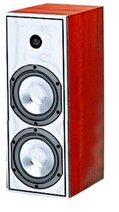

Figure 4: 3-way speaker
From a optical look in a store: 3-wayers and 2.5-wayers can seldom be directly distinguished in the classic electrical wholesale stores.
A well-known and technically experienced German loudspeaker manufacturer has been talking about 3-way loudspeakers in his own forum a few years ago. According to him there is no reason to rely on 3-way constructions for passive loudspeakers. According to his statements there are no advantages that justify the more complex crossover structures with correspondingly worse impulse behaviour of 3-way compared to 2.5-way. The explanations were sound and comprehensible - interestingly enough the same manufacturer now offers his top models with a 3-way design.

The advantage of 3-Wayers is that three drivers of different sizes can be used with optimal adaptation to the different wavelengths in the low/mid/high range. This results in more consisten radiation and lower distortion.
Due to the slim speaker fronts of "beautiful" speakers, however, it is not possible for the manufacturer to install real woofers of 40cm or more. Most hifi speakers use woofers that are more likely to pass as large midrange speakers in terms of diameter (max 15-20cm). With the appropriate excursion even small drivers can deliver low bass and level - but with bundled radiation in the lower midrange only large woofers help.
The (low) bass relief of the midrange drivers also allows exotic midrange systems to be used as the cone loudspeakers with high excursion: for example domes and ribbons.
Some manufacturers place large woofers on the side of the cabinets. This allows fashionably slim cabinet fronts and at the same time big bass. Due to the side mounting, a big advantage, the bundling in the fundamental tone, cannot be used. Why would you want a side-radiating basic tone? At very low frequencies the loudspeaker radiates in a spherical shape, the position of the bass driver is irrelevant.
In order to operate the bass drivers only in the omnidirectional range the bass frequencies are usually cut off below 150Hz. Accordingly, the drivers should rather be seen as separate subwoofers. The low bass support of the big basses and the relief of the bass-midrange driver can increase the maximum level of the loudspeaker considerably. The highly pronounced omnidirectional radiation behaviour at low and mid frequencies is in some cases even more pronounced than with classic 3-way speakers thanks to the particularly slim cabinet fronts: d'Appolito arrangements for the mid-range drivers and sound guides for the tweeters are accordingly often chosen in order to enhance the bundling. Depending on the speaker this can give the impression of half-hearted damage minimisation.
The mini far-field loudspeaker
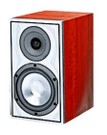
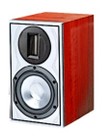
Figure 5: Mini far fields
Small studio monitors often have sound sources for the tweeters in order to achieve a constant directivity despite the high crossover frequency for the mid-bass drivers. With normal living room acoustics these monitors have a sharper stage image in the mid/high range. Due to the small baffle and the small woofers no bundling can be achieved in the fundamental tone - the loudspeaker radiates round at the bottom and strongly bundled at the top, the diffuse sound and thus the sound impression is inevitably darkened. This loudspeaker is only suitable to a limited extent for sound reinforcement at listening positions that are far apart. For the sound reinforcement of individual listening places, however, such a loudspeaker is worth considering. After all, the stronger tweeter concentration makes one more independent of the acoustics.
Sound guides are not the only possibilities for a "mini far-field loudspeaker": large ribbon tweeters have a stronger directivity than small domes due to their large surface area. Often the ribbon tweeters are combined with waveguides and score points due to the highly directional tweeter with a transparent and sharp stage presentation. Coaxial drivers, where the woofer de facto serves as a waveguide, are also used.
Professional small monitors are usually equipped with highly directional midrange/treble units. Corresponding loudspeakers are of course also available for the hifi market.
The large far field loudspeaker
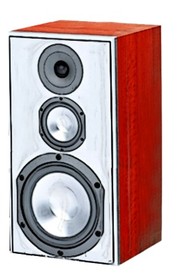
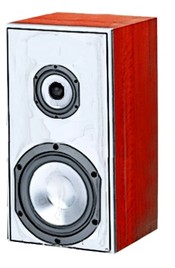
Figure 6: Full-field loudspeakers
The classic hifi speakers from Braun and Grundig from the past decades were often big 3-way speakers. Unfortunately, such large loudspeakers are not available on the private market today for optical reasons - unfortunately. A largely uncompromising implementation is shown below by the company Genelec.
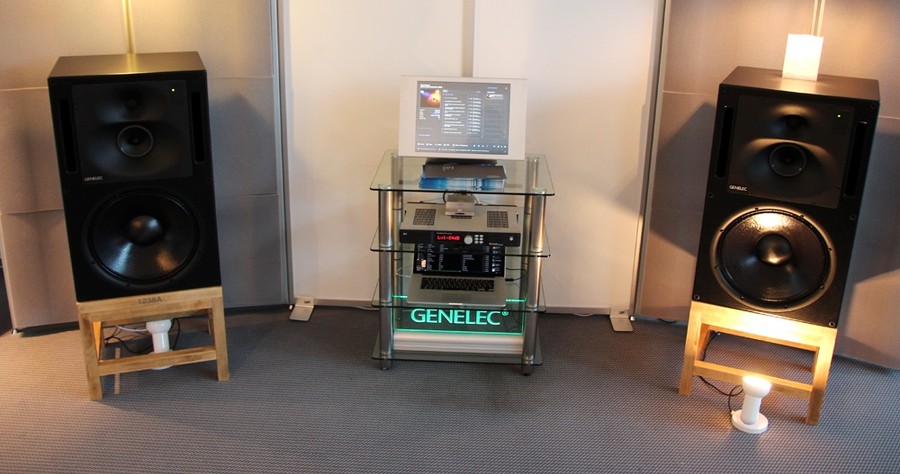
Figure 6: Far-field loudspeaker from Genelec
The fundamental tone is bundled by the large baffle width and the large woofers - accordingly, more strongly bundled tweeter units can be used without the diffuse sound frequency response of the speakers becoming discoloured. If all drivers are driven to self-bundling in order to achieve an average bundle size that is suitable for the living room, the radiation behaviour at the crossover frequencies must be stabilised. Usual solutions are coaxial drivers or waveguides.
The large-volume cabinets and the large bass drivers also allow deep bass at high levels. The level stability of the tweeters/midrange drivers due to the high separation also increases significantly.
The midrange driver usually works between 600 and 3000 Hz in such arrangements - and from a hearing psychology point of view it is de facto a full range driver: after all, it alone covers the frequency range in which the ear is most sensitive. Reproduction errors in the crossover frequency range are shifted to less important frequency ranges.
Due to the low excitation of the short-term reflections such a loudspeaker can be placed comparatively well near a wall - and ironically, despite its large dimensions, it is perfectly suited for small rooms where a free placement is not possible. At best, large distances between the drivers can cause the sound image to "disintegrate" too much at very short listening distances.
Examples for different concepts
In the following two loudspeakers are shown which were designed as neutral loudspeaker concepts.

Figure 7: Large (top) and small (bottom) far field loudspeakers
Both loudspeakers have a certain amount of bundling. The upper speaker has similar dimensions as a good oven - and has a corresponding bass driver, the bundling starts very early. The lower loudspeaker is considerably smaller and can be placed on a desk without any problems - without breaking through the table top.
The lower loudspeaker relies on extremely strong bundling in the tweeter to improve the far field characteristics. The considerably larger loudspeaker radiates a much wider overall, but correspondingly evenly.